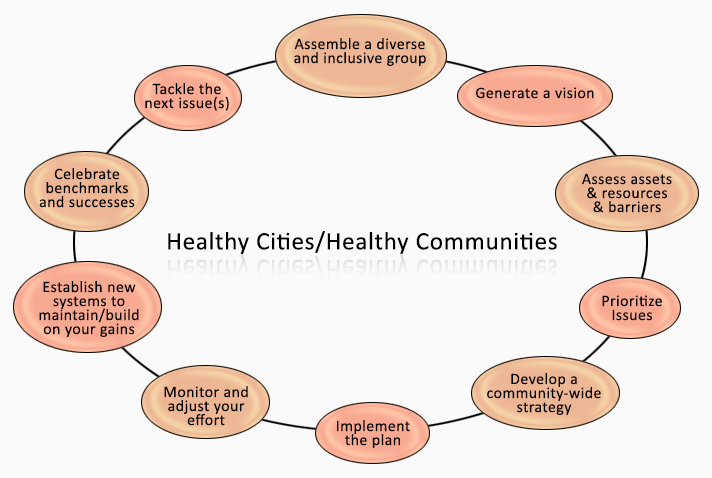Session Three: Healthy Cities Movement Framework and Information for Assignment #1 Due March 3, 2021
This session will focus on the “healthy cities movement”, a long-term international development initiative sponsored by the World Health Organization that places health high on the agenda of decision makers and promotes comprehensive local strategies for health protection and sustainable development in cities. The basic features of the healthy cities model include: community participation and empowerment, intersectional partnerships, and participant equity. The healthy cities movement defines a “healthy city” as: A city that is continually creating and improving those physical and social environments and expanding those community resources which enable people to mutually support each other in performing all the functions of life and developing to their maximum potential. In this session we will address the following questions:
- What principles and values undergird the healthy cities initiative and movement?
- Can these principles and values guide us as we think about alternative urban futures?
- What can we learn about the future of cities from the healthy cities movement?
- What are the social determinants of health and why are they important for healthy cities?
Required Reading
- The Healthy Cities Movement: Working Paper For The Lancet Commission On Healthy Cities
- A Healthy City For All: Vancouver’s Healthy City Strategy 2014-2025
- The Healthy Eating Plate https://cdn1.sph.harvard.edu/wp-content/uploads/sites/30/2012/09/HEPJan2015.jpg
- CSA Community supported agriculture https://www.localharvest.org/csa/
Videos (SECRET DO NOT WATCH)
- WHO: Towards Making a Healthy City – 6 minutes
- Making The Connections: Our City, Our Society, Our Health – (3.48 minutes)
- When Healthy Meets City | Marianne LeFever – 17 minutes
- NYC coalition against hunger csa fundraiser https://www.youtube.com/watch?v=U-1z4eUpCY0
Notes
- Healthy cities movement was founded by public health experts, not by urban planners.
- Healthy cities movement takes public health needs of individuals and applies it to the urban context.
- Healthy cities model developed at a meeting in Ottowa
-
- Human body needs;
- low pollution
- clean water
- sufficient nutritious food
- etc
- Social determinants of health
- access to adequate housing
- access to healthcare
- access to sufficient income
- access to safe environment
- etc
- If you have these or dont have these then you will be more or less healthy vs ill
- Peace: young black men were at greater risk of physical harm at home then at war
- Shelter
- Education that is free, adequate, available, and accessible to all
- Food, enough and adequate
- Income adequate to support a reasonable quality of life
- clean air
- sustainable resources
- Social justice: people are not mistreated of discriminated against by those more powerful
- Equity
- Human body needs;
- Comprehensive view of health
- education
- diversity
- inclusion
- food security
- health care
- affordable housing
- walkability
- access to public transportation
- good dispersion of green space
-
- Healthy city wheel model from last week’s reading

- Assemble a diverse and inclusive group
- Create a vision
- Assess assets, resources, and barriers
- Prioritize issues
- Develop a community-wide strategy
- Implement the plan
- Monitor and adjust your effort
- Establish new systems to maintain/build on your gains
- Celebrate benchmarks and successes
- Tackle the next issue
- For the assignment
- Answer who is included in the group
- Identify the ways they are not homogeneous
- Answer who is included in the group
- What factors drive the decisions urban decision makers consider
- money
- personal gain
- how to attract businesses and employment
- manage cities in ways that attract rich people
- increase tax base
- how to prevent getting sued
- what ideologies are en vogue
- legacy building
- increase public safety
- lulu siting/ nimbys
- how to build a positive image of the city
- money
- what factors drive the decisions public health officials consider
- access to clean water, air, food
- income
- shelter
- environmental factors
- education
- conflict, violence, safety
- stressors
- indicators
- vulnerability index
- child health indicators
HOMEWORK ASSIGNMENT: DUE February 17th FOR SESSION FOUR
- Watch the video below and summarize what you learned from Prof Stiglitz and be prepared to share what you learned with the class Joseph Stiglitz “How Inequality In Today’s Society Endangers Our Future” (1 hour)
- Watch the video below and summarize the statistical information provided in the video and be prepared to share what you learned with the class The Insane Scale of Global Wealth Inequality Visualized, 2019 https://www.youtube.com/watch?v=caBDPFx2et4 (9 minutes)
- Update the statistics on billionaires by going to the website inequality.org update and be prepared to share what you learned with the class